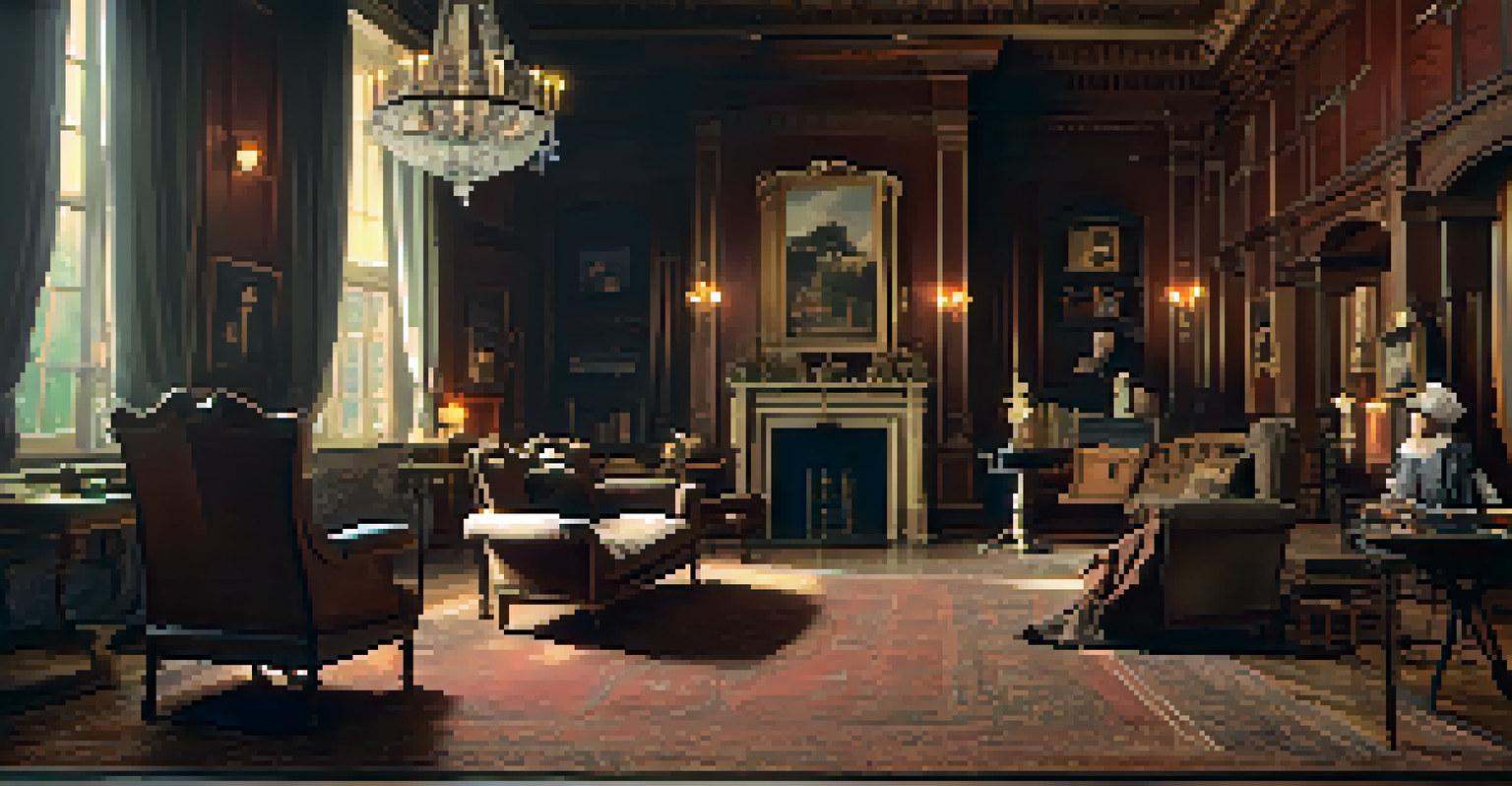Adapting Classic Literature: Challenges Filmmakers Face Today

Understanding the Source Material: A Double-Edged Sword
When filmmakers set out to adapt classic literature, they often face the challenge of deeply understanding the source material. Novels like 'Pride and Prejudice' or 'Moby Dick' come with rich narratives and nuanced characters that can be daunting to translate to screen. This depth is what makes these works timeless, but it also raises the stakes for filmmakers who want to honor the original while making it accessible to modern audiences.
The greatest adaptations of classic literature are those that manage to be faithful to the source while also breathing new life into it.
Moreover, the interpretation of classic texts can vary widely, leading to debates about fidelity versus creativity. Filmmakers must decide which elements of the story to emphasize or alter, which can lead to controversy among fans of the original work. This balancing act is crucial; a faithful adaptation might resonate with purists but risk alienating new viewers who are unfamiliar with the source material.
In this context, filmmakers often find themselves in a position akin to tightrope walking. They must navigate the expectations of avid readers while also appealing to those who may not have read the book at all. The challenge lies in striking the right balance between staying true to the text and crafting a compelling cinematic experience.
Cultural Relevance: Bridging the Past and Present
One significant challenge in adapting classic literature is ensuring that the themes resonate with today's audience. Many classic works reflect the societal norms and values of their time, which can feel outdated or even problematic in a modern context. Filmmakers must thoughtfully consider how to retain the essence of the story while updating certain elements to reflect contemporary issues and sensibilities.

For example, adaptations of works like 'Jane Eyre' or 'The Great Gatsby' often involve reinterpreting character motivations and societal roles. This approach can breathe new life into the narrative, making it relevant for a 21st-century audience. However, it also requires a delicate touch to avoid diluting the original message or misrepresenting the characters.
Balancing Fidelity and Creativity
Filmmakers must navigate the fine line between staying true to the source material and making it accessible to modern audiences.
This ongoing dialogue between past and present enriches the adaptation process. It allows filmmakers to explore timeless human experiences—like love, ambition, and class struggle—while presenting them in a way that feels fresh and engaging. The challenge lies in making these connections clear and meaningful without losing sight of what made the original work significant.
Character Development: Staying True to the Original
Classic literature is often celebrated for its complex characters, and adapting these figures can be a significant challenge for filmmakers. When a character is beloved in a novel, fans often have a specific vision of who they are, and any deviation can lead to disappointment. Filmmakers must carefully consider how to portray these characters on screen while ensuring they remain true to their literary origins.
A film is not a book. It is a different medium that allows for different kinds of storytelling.
For instance, take the character of Elizabeth Bennet from 'Pride and Prejudice.' Each adaptation brings a different interpretation of her wit and independence, which can spark discussions among fans. Filmmakers must capture the essence of these characters while also giving them enough depth to engage viewers who may not have read the original work.
Ultimately, character development in adaptations requires a keen understanding of the source material and a creative vision that respects its legacy. Balancing these aspects can be tricky, but when done right, it can lead to a portrayal that honors the original while standing on its own as a compelling narrative.
Visual Storytelling: The Art of Interpretation
Film is a visual medium, and adapting literature into a visual story presents unique challenges. Unlike a novel, which allows for detailed inner thoughts and descriptions, film relies heavily on imagery and dialogue to convey a story. This shift necessitates a creative reimagining of scenes and character interactions, requiring filmmakers to think outside the box.
For example, adapting the intricate settings of 'The Count of Monte Cristo' into a visually stunning film involves careful planning and artistic direction. Filmmakers must distill complex scenes into potent visuals that capture the viewer's imagination. This artistic interpretation can either enhance the story or detract from its original impact, making it a critical aspect of the adaptation process.
Adapting to Modern Themes
Updating classic literature involves reinterpreting characters and themes to resonate with contemporary issues while retaining the original essence.
Moreover, the use of cinematography, color palettes, and sound design can significantly influence how the story is perceived. These elements must work in harmony to evoke the same emotions and themes found in the text. Thus, visual storytelling becomes a powerful tool that filmmakers can use to breathe new life into classic literature, provided they approach it thoughtfully.
Audience Expectations: Balancing Tradition and Innovation
When adapting classic literature, filmmakers must navigate the tricky waters of audience expectations. Many viewers come to adaptations with preconceived notions shaped by their familiarity with the book, and this can influence their reception of the film. Balancing tradition with innovation is crucial for filmmakers who want to create a successful adaptation.
For instance, adaptations of 'Les Misérables' have varied widely in approach, from faithful interpretations to more modern takes. Each version has its own audience, and filmmakers must be aware of these expectations while crafting their vision. This balancing act often requires a deep understanding of both the source material and the audience's desires.
Ultimately, striking the right balance can lead to a successful adaptation that resonates with both fans of the original work and newcomers alike. Filmmakers who can navigate these expectations often find that their adaptations achieve a broader appeal, creating a bridge between the classic text and today's diverse audience.
Financial Constraints: The Budgeting Battle
Another significant challenge faced by filmmakers adapting classic literature is financial constraints. Producing a film that captures the grandeur and depth of a literary classic often requires a hefty budget. From elaborate sets to a talented cast, the costs can quickly add up, making it essential for filmmakers to creatively manage their resources.
For instance, adaptations of epic novels like 'War and Peace' demand not only a strong script but also impressive production values. Filmmakers may need to make tough decisions about which elements to prioritize, often resulting in compromises that can affect the final product. This pressure to deliver quality within budgetary limits can be a significant hurdle.
Financial Constraints Drive Innovation
Budget limitations can challenge filmmakers but also inspire creative solutions that lead to fresh interpretations of classic works.
However, financial constraints can also spark innovation. Filmmakers may find creative solutions to tell the story in unique ways that do not require extensive resources. This adaptability can lead to fresh interpretations of classic works, reminding us that sometimes, limitations can inspire the most creative outcomes.
The Role of Technology: Enhancing or Distracting?
In today's digital age, technology plays a pivotal role in film production, which can both assist and complicate the adaptation of classic literature. Special effects, CGI, and advanced editing techniques can enhance storytelling, allowing filmmakers to visualize elements of the narrative that may have been challenging to represent in the past. This technology opens new doors for creativity and innovation.
However, reliance on technology can also lead to distractions. Some filmmakers risk overshadowing the narrative with flashy effects that detract from the story's core message. For example, an adaptation of 'Frankenstein' might focus so heavily on visual spectacles that it loses the emotional depth of the characters and themes that originally drew audiences to Mary Shelley's work.

Thus, the challenge lies in using technology as a tool to enhance storytelling rather than allowing it to dominate the narrative. When filmmakers strike the right balance, technology can elevate an adaptation, providing audiences with a visually stunning experience that complements the timeless themes of classic literature.